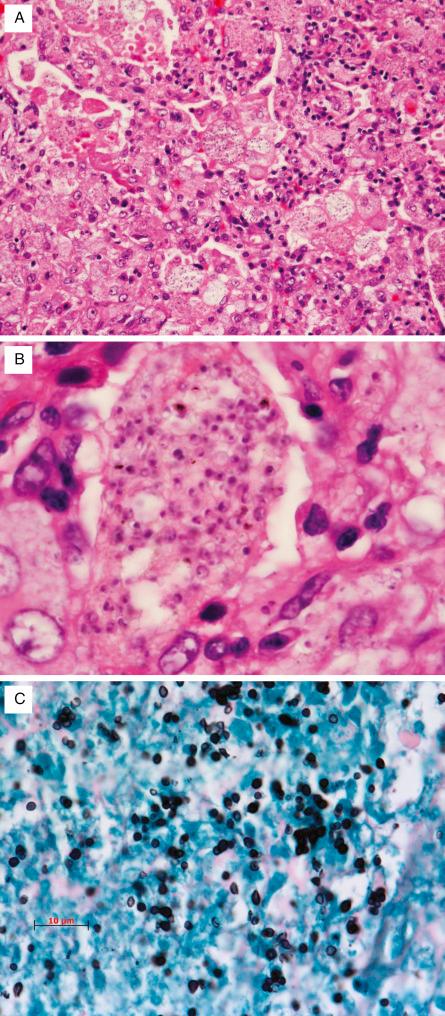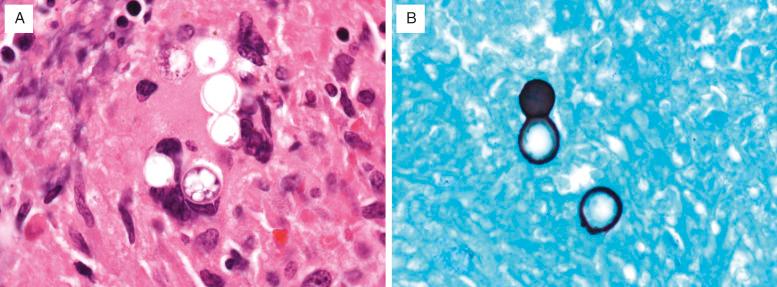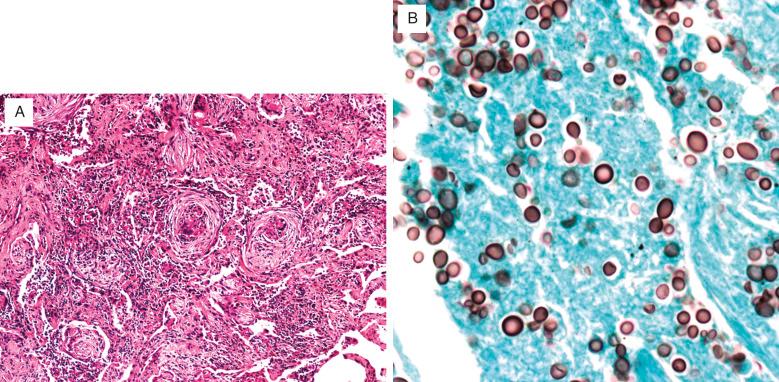Physical Address
304 North Cardinal St.
Dorchester Center, MA 02124
Fungi are unicellular or multicellular organisms that have chitinous cell walls and reproduce asexually, sexually, or both ways. Fungal cells are larger and more complex than bacteria, with cell walls containing polysaccharides, proteins, and sugars. Pulmonary fungal infections typically follow inhalation of aerosolized fungi from the environment. The infections can remain either localized to the lungs or can disseminate to produce systemic disease in immunocompromised individuals. Common fungal infections and a selection of uncommon fungal infections are discussed in this chapter.
Although histologic examination and microbiologic cultures are the gold standard for the diagnosis of fungal infections, antigen- and polymerase chain reaction (PCR)–based diagnostic assays are being increasingly utilized for this purpose. Antigen-based testing for early diagnosis includes the β-glucan assay for invasive fungal infections, galactomannan assay for invasive aspergillosis, and a recent variation on the traditional cryptococcal antigen test with a lateral flow assay for invasive cryptococcosis. PCR-based diagnostic tests also provide highly sensitive and rapid diagnosis. Other tests that are being developed for diagnosis of fungal infections include those incorporating proteomic approaches such as matrix-assisted laser desorption ionization time of flight mass spectroscopy. At present, however, most of the molecular tests require standardization and are mainly used to complement conventional diagnostic tests.
Respiratory infection caused by Histoplasma capsulatum var. capsulatum
Endemic in midwest states of United States
Common in avian and chiropteran habitats
Infections asymptomatic in almost 75%
25% develop symptomatic disease manifested as:
Acute infection with pulmonary infiltrates and hilar lymphadenopathy
Disseminated infection (in immunocompromised patients) with generalized symptoms and high mortality
Chronic infection with symptoms similar to other chronic pulmonary infections; radiologic patterns may show infiltrative, cavitary, fibrotic, and nodular lesions
Fibrosing mediastinitis with slowly progressive collagen proliferation and entrapment of vital mediastinal structures
Acute histoplasmosis is self-limited
Mortality in immunocompromised patients with progressive and disseminated infections is high (up to 80% without treatment)
Acute infection has patchy bronchopneumonia and hilar adenopathy
Disseminated infection shows edema, congestion, and granulomas
Chronic infection has diffuse infiltrative lesions, apical bilateral cavitary lesions, bronchiectasis, or histoplasmomas or “coin lesions”
Granulomas with or without central necrosis surrounded by lymphocytes, macrophages, and multinucleated giant cells
The fungus is oval, 2 to 5 microns, with narrow-based budding, often seen in the center of the granuloma; there may be a “halo effect” from retraction of the cell wall, and rarely pseudohyphae and germ tubes may be seen
C. glabrata
P. marneffei
Poorly encapsulated cryptococci
Microforms of B. dermatitidis
Leishmania amastigotes
T. gondii
Histoplasmosis is a respiratory infection caused by inhalation of infectious conidia or mycelia of Histoplasma capsulatum var. capsulatum. In the United States the Mississippi and Ohio River valleys are highly endemic areas. The avian and chiropteran habitats such as chicken coops, roosting shelters, caves, and attics favor the growth and multiplication of Histoplasma in soil enriched with fecal material.
Almost 75% of infections are asymptomatic and self-limited and heal without treatment. The remaining 25% of patients may develop symptomatic disease manifested as (1) acute pulmonary disease, (2) disseminated disease, (3) chronic pulmonary disease, and (4) fibrosing mediastinitis.
Acute pulmonary disease clinically manifests as fever with cough and chest pain, approximately 1 to 4 weeks after exposure. Symptoms can resolve in a few days to 2 weeks, but may persist up to several months. Disseminated histoplasmosis is seen in patients with impaired cell-mediated immunity, with development of severe systemic symptoms, including weight loss, malaise, hepatosplenomegaly, purpura, and oropharyngeal and intestinal ulcerations. The mortality without antifungal therapy can be as high as 80%. Chronic pulmonary histoplasmosis is primarily a disease of adults with symptoms similar to other chronic progressive pulmonary infections such as tuberculosis.
Fibrosing mediastinitis is a histologically benign disorder caused by proliferation of collagen within the mediastinum as a result of histoplasmosis; however, cases secondary to tuberculosis, zygomycosis, and Langerhans cell histiocytosis are also reported. Most of the patients are young and present with respiratory symptoms. The disease is slowly progressive and may result in extensive fibrosis with entrapment and invasion of structures adjacent to the mediastinal lymph nodes, including the heart, great vessels, and esophagus.
In the acute phase, chest radiographs may show hilar lymphadenopathy and a single small area of pulmonary infiltrate forming the primary complex. With disease evolution, chest radiographs may show patchy nodular pulmonary infiltrates and pleural effusion. Four radiologic patterns have been described in chronic pulmonary histoplasmosis: infiltrative, cavitary, fibrosis with emphysema, and residual solitary nodule or histoplasmoma.
In the acute pulmonary disease, patchy bronchopneumonia and hilar lymphadenopathy may be seen. In disseminated histoplasmosis, the lungs may show edema, congestion, and granulomas. Chronic pulmonary histoplasmosis may be seen as diffuse pulmonary infiltrates, frequently apical, but may be bilateral and associated with cavitary lesions, as seen in tuberculosis. Fibrosis may be severe and associated with bronchiectasis. Histoplasmoma, or the “coin” (lesion), may be confused with carcinoma, especially when it is noncalcified. However, histoplasmomas are often rounded, subpleural, and show a concentric calcification pattern, accompanied by enlarged and calcified hilar lymph nodes.
The characteristic histologic lesion of histoplasmosis is a granuloma, with or without central necrosis, surrounded by lymphocytes, macrophages, and multinucleated giant cells. The fungus is an oval, 2- to 5-micron yeast that does not have a capsule and shows narrow-necked budding ( Fig. 12.1 ). The yeast often occurs in clusters, due to its intracellular proliferation in phagocytes. In hematoxylin-eosin–stained sections, the basophilic cytoplasm of the yeast is often retracted from the poorly stained cell wall, creating a false impression of an unstained capsule or a “halo” effect. Poorly formed pseudohyphae consisting of cells attached to each other and germ tubes are often seen in active lesions. The yeast stains strongly with methenamine silver (GMS) stain and may be seen in the central areas of old “coin” lesions. The histoplasmoma consists of a large central zone of caseous necrosis surrounded by a thick fibrous capsule that contains lymphoid aggregates and rare epithelioid and multinucleated giant cells. The central necrotic material may be calcified and may show osseous or myeloid metaplasia.

The differential diagnosis includes Candida glabrata, which is of similar size but amphophilic and without a “halo” effect on H & E stain. Penicillium marneffei is also of similar size and shape but does not bud and divides by fission through the center and can form short hyphaelike or allantoid forms. Poorly encapsulated cryptococci may appear similar but are round, have narrow point budding, are pleomorphic, and stain with mucicarmine. Microforms of Blastomyces dermatitidis should be considered but are multinucleated, with thick double-contoured walls, and have broad-based budding.
Leishmania amastigotes have dotlike intracellular basal bodies or kinetoplasts. However, these do not stain with GMS. Toxoplasma gondii also has a similar appearance and stains with H & E, but does not show budding and does not stain with GMS.
Acute histoplasmosis is usually a benign, self-limited infection that heals without antifungal therapy. However, the progressive pulmonary and disseminated infections require prompt and sometimes prolonged treatment with either amphotericin B or one of its lipid formulations, ketoconazole, itraconazole, or fluconazole. Newer antifungal agents such as triazole and posaconazole are also being used. Fibrosing mediastinitis may require antifungal therapy combined with corticosteroids.
Systemic infection caused by the dimorphic fungus B. dermatitidis
Endemic in southeastern, south central, and midwestern states of United States
Natural habitat most likely wood
Self-limited illness, frequent in young males
Acute infection with flulike illness, pneumonia, high fever, and pleuritic chest pain
Rarely acute respiratory distress syndrome and cavitary lesions
Chronic infection with fever, weight loss, and night sweats
Acute infection has bilateral patchy consolidation most often in the posterior segments of the lower lobes and pleural effusion
Severe acute infection may cause lobar consolidation
Chronic infection shows linear pulmonary infiltrates, fibronodular densities, and cavitation
Acute primary infection is self-limited, but long-term follow-up is recommended to detect extrapulmonary infection
Nodular or miliary pattern with hyalinization, fibrosis, and cavitation of nodules
Pulmonary–lymph node complex infrequent
Characteristic lesion is abscesslike neutrophil collection surrounded by palisading macrophages, lymphocytes, plasma cells, and multinucleated giant cells, with fungus at the edge of the abscess
Fungus is 8 to 15 microns in diameter, has a thick cell wall, and solitary blastoconidium attached by a broad septum
H. capsulatum var. duboisii
C. neoformans
C. immitis
Blastomycosis is a systemic infection caused by the dimorphic fungus B. dermatitidis. The disease is endemic in the southeastern, south central, and midwestern United States; however, cases have been reported from northern states and Canada also. The natural habitat and precise ecologic niche of B. dermatitidis are not completely understood; however, it appears that the fungus exists as a wood saprophyte, and infection occurs through inhalation. Its asexual phase is called B. dermatitidis and its sexual phase Ajellomyces dermatitidis.
The disease occurs most frequently in young males and presents either as acute or chronic infection. Pulmonary infection can either remain confined to the lungs or disseminate hematogenously to other organs, and it may be fatal in severe progressive infections. After inhalation of the infectious conidia, patients develop a nonspecific flulike illness progressing to acute pneumonia, with high fever and pleuritic chest pain. Symptoms may persist for a few days to 2 weeks and often result in a self-limited infection. Rarely a more rapid clinical course with development of acute respiratory distress syndrome (ARDS), pulmonary necrosis, and cavitation may be seen. Chronic blastomycosis presents with respiratory symptoms lasting weeks to months, associated with fever, chest pain, weight loss, and night sweats.
Acute pulmonary blastomycosis manifests as patchy areas of consolidation, often bilateral, and less commonly associated with pleural effusion and cavitations. The posterior segments of lower lobes are most often involved, but middle and upper lobes may also be affected. A severe infection may result in lobar consolidation and formation of miliary infiltrates. Chronic blastomycosis is associated with linear pulmonary infiltrates, fibronodular densities with cavitations similar to chronic active tuberculosis, and mediastinal lymphadenopathy. Pleural involvement is common.
The lesions of blastomycosis may have a nodular pattern mimicking localized tumors or a miliary pattern. Chronic pulmonary lesions show fibrosis, hyalinization of the nodules, and cavitation, similar to that seen in other granulomatous diseases. A primary pulmonary–lymph node complex is much less frequent than in histoplasmosis. Solitary residual fibrocaseous nodule “coin” lesions are rare, and calcification is even rarer.
B. dermatitidis is a dimorphic fungus that measures 8 to 15 microns in diameter with a thick cell wall and solitary blastoconidia attached by a broad-based septum ( Fig. 12.2 ). The lesions are characterized by abscesslike neutrophil collections, surrounded by epithelioid or palisading macrophages and multinucleated giant cells. The fungus is found usually at the edge of the abscesses, and calcification is not common.

The differential diagnosis includes Histoplasma capsulatum var . duboisii, which has broad-based attachments. Small atypical forms of B. dermatitidis can be confused with H. capsulatum; however, microforms of blastomyces are always present as part of a continuum of small to large yeast forms. Cryptococcus neoformans is similar in size as blastomyces, but is mucicarmine-positive. Coccidioides immitis is distinguished by the presence of spherules with double walls.
Acute primary blastomycosis is often self-limited, and antifungal therapy is not required. However, long-term follow-up is necessary because patients may present with extrapulmonary lesions from months to years after resolution of the primary pulmonary infection. Itraconazole and amphotericin B are the drugs of choice.
Systemic infection caused by C. neoformans or C. gatti, usually acquired from avian excreta
Acute pulmonary infection may be asymptomatic, transient colonization of respiratory tract, or self-limited pulmonary disease
Residual “cryptococcomas” are subpleural small nodules without calcification
Progressive infection, seen in immunocompromised patients, is either asymptomatic or has low-grade fever, cough, pleuritic pain, and weight loss
Interstitial infiltrates, nodules, consolidation, pleural effusion, empyema, and hilar lymphadenopathy
Upper lobes are more often involved
Fibrosis and calcification are uncommon
Depends on immune status and the severity and extensiveness of the infection
Severe infection has diffuse miliary lesions or patchy consolidation with mucoid surface on cut section
Cryptococcomas are nodules that show central necrosis and cavitation but no calcifications
Immunocompromised host has profusely multiplying yeasts filling the alveoli, alveolar septa, and capillaries
Immunocompetent hosts have a granulomatous response with caseation and fibrosis
Pleomorphic, eosinophilic, uninucleate, thin-walled round yeast forms, 2 to 20 μm, surrounded by a wide, clear capsule and narrow-based budding
Only pathogenic fungus that stains with mucin stains (mucicarmine, alcian blue)
Capsule-deficient small C. neoformans stain black or brown with Fontana-Masson stain
Capsule-deficient forms of C. neoformans need to be differentiated from:
H. capsulatum var. capsulatum
B. dermatitidis microforms
S. schenckii
C. glabrata
Candida spp.
Immature spherules of C. immitis
Cryptococcosis is a systemic infection caused predominantly by the yeast Cryptococcus neoformans or Cryptococcus gatti, which affects both immunocompromised and nonimmunocompromised hosts. Most cases occur in patients with advanced HIV disease, but a growing number are seen in solid-organ transplant recipients and those receiving immunosuppressive treatment for other diseases. C. gatti infection can occur in immunologically competent hosts. The yeast is found in avian, particularly pigeon, excreta. The respiratory tract is the portal of entry for aerosolized cryptococci in human infections. Disseminated cryptococcosis is almost always seen in immunocompromised hosts.
Two clinical forms of cryptococcosis are seen: pulmonary and cerebromeningeal. The pulmonary disease may present in three different forms: (1) transient, asymptomatic colonization of tracheobronchial tree; (2) self-limited or progressive pulmonary disease, with or without extrapulmonary dissemination; and (3) residual pulmonary nodule or “cryptococcoma.” Colonization of the respiratory tract is seen in patients who have preexisting lung disease, such as tuberculosis, chronic bronchitis, asthma, neoplasms, and allergic bronchopulmonary aspergillosis. An invasive infection is not seen in these patients. The majority of immunocompetent people with cryptococcosis have asymptomatic or self-limited pulmonary infections with formation of residual fibrocaseous nodules or cryptococcomas. These nodules are usually subpleural, rounded, 0.2 to 7.0 cm in diameter, and show no calcification. Rarely, a primary pulmonary–lymph node complex may be formed. Progressive pulmonary infection may be asymptomatic or associated with low-grade fever, cough, pleuritic chest pain, and weight loss.
Chest radiographs may show interstitial infiltrates, nodules that resemble neoplasms, segmental or lobular consolidation, and, less commonly, hilar lymphadenopathy, pleural effusion, and empyema. The upper lobes are reportedly more frequently involved. Fibrosis and calcification are uncommon. Diffuse interstitial, peribronchial, or miliary infiltrates can develop in profoundly immunodeficient patients.
The severe infection often seen in patients with AIDS presents as diffuse miliary lesions or as areas of patchy consolidation with a mucoid appearance in freshly sectioned lungs. Sometimes cystic lesions composed of densely packed organisms may be seen in immunodeficient patients. In immunocompetent individuals, lesions remain localized and either resolve or become granulomatous with formation of nodules. The firm grayish-white fibrocaseous nodules, “cryptococcomas,” show central necrosis and cavitation, and resemble lesions seen in histoplasmosis and coccidioidomycosis; however, these lesions rarely show calcifications. Smaller satellite nodules may also be present.
In H & E–stained tissue sections, typical cryptococci appear as pleomorphic, eosinophilic, uninucleate, thin-walled, round yeast forms, 2 to 20 microns in diameter, surrounded by a wide, clear polysaccharide capsule ( Fig. 12.3 ). Budding is seen as a single blastoconidium attached to the parent cell by a narrow neck. Active lesions can contain a large number of rapidly dividing cryptococci. The fungi stain with usual fungus stains, as well as with mucin stains such as mucicarmine and alcian blue. Cryptococcus species are the only common pathogenic fungi that produce mucinous capsular material. The host response to C. neoformans depends on the immune status of the host, with immunodeficient patients developing profuse multiplying lakes of cryptococci with little surrounding host response. The cryptococci may appear to fill the alveolar spaces and the thickened alveolar septa and septal capillaries. Immunocompetent individuals and capsule-deficient strains of cryptococci may cause a granulomatous inflammatory response with caseation and fibrosis surrounding the small 2 to 4 micron in diameter capsule-deficient and distorted cryptococci. In these lesions, GMS or modified Fontana-Masson stain can be used to identify the poorly encapsulated cryptococci.

The capsule-deficient small C. neoformans should be differentiated from H. capsulatum var. capsulatum; microforms of B. dermatitidis, S. schenckii, C. glabrata blastoconidia of Candida species; and immature spherules of C. immitis. A Fontana-Masson stain is helpful, because capsule-deficient cryptococci stain black or brown with this stain; however, S. schenckii and C. immitis spherules may also stain positive.
Amphotericin B and 5-fluorocytosine is the treatment of choice for progressive pulmonary cryptococcosis and cerebromeningeal cryptococcosis. Maintenance suppressive therapy with fluconazole can be used.
Most common opportunistic infection in immunocompromised patients
C. albicans is a true endogenous pathogen
Fever, cough, and dyspnea
Almost 50% have negative radiographs
Patchy or diffuse bilateral consolidation, miliary nodules, pulmonary edema, hemorrhage, infarcts, or diffuse alveolar damage may be seen
Candida septicemia has a high mortality rate
Become a Clinical Tree membership for Full access and enjoy Unlimited articles
If you are a member. Log in here